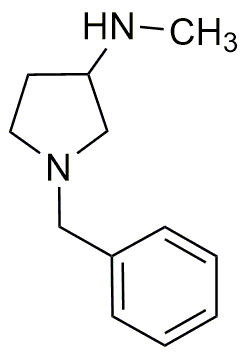1-Benzyl-3-(methylamino)pyrrolidine is widely utilized in research focused on:
- Pharmaceutical Development: This compound serves as a key intermediate in synthesizing various pharmaceuticals, particularly in the development of new psychoactive substances.
- Neuroscience Research: Its structural properties make it valuable for studying neurotransmitter systems, helping researchers understand conditions like depression and anxiety.
- Analytical Chemistry: Used as a standard in chromatography, it aids in the analysis of complex mixtures, ensuring accurate identification and quantification of compounds.
- Material Science: The compound can be incorporated into polymers to enhance their mechanical properties, making it useful in creating stronger, more durable materials.
- Cosmetic Formulations: Its unique chemical structure allows it to be used in developing skin care products, providing benefits such as improved texture and stability.
General Information
Properties
Safety and Regulations
Applications
1-Benzyl-3-(methylamino)pyrrolidine is widely utilized in research focused on:
- Pharmaceutical Development: This compound serves as a key intermediate in synthesizing various pharmaceuticals, particularly in the development of new psychoactive substances.
- Neuroscience Research: Its structural properties make it valuable for studying neurotransmitter systems, helping researchers understand conditions like depression and anxiety.
- Analytical Chemistry: Used as a standard in chromatography, it aids in the analysis of complex mixtures, ensuring accurate identification and quantification of compounds.
- Material Science: The compound can be incorporated into polymers to enhance their mechanical properties, making it useful in creating stronger, more durable materials.
- Cosmetic Formulations: Its unique chemical structure allows it to be used in developing skin care products, providing benefits such as improved texture and stability.
Documents
Safety Data Sheets (SDS)
The SDS provides comprehensive safety information on handling, storage, and disposal of the product.
Product Specification (PS)
The PS provides a comprehensive breakdown of the product’s properties, including chemical composition, physical state, purity, and storage requirements. It also details acceptable quality ranges and the product's intended applications.
Certificates of Analysis (COA)
Search for Certificates of Analysis (COA) by entering the products Lot Number. Lot and Batch Numbers can be found on a product’s label following the words ‘Lot’ or ‘Batch’.
*Catalog Number
*Lot Number
Certificates Of Origin (COO)
This COO confirms the country where the product was manufactured, and also details the materials and components used in it and whether it is derived from natural, synthetic, or other specific sources. This certificate may be required for customs, trade, and regulatory compliance.
*Catalog Number
*Lot Number
Safety Data Sheets (SDS)
The SDS provides comprehensive safety information on handling, storage, and disposal of the product.
DownloadProduct Specification (PS)
The PS provides a comprehensive breakdown of the product’s properties, including chemical composition, physical state, purity, and storage requirements. It also details acceptable quality ranges and the product's intended applications.
DownloadCertificates of Analysis (COA)
Search for Certificates of Analysis (COA) by entering the products Lot Number. Lot and Batch Numbers can be found on a product’s label following the words ‘Lot’ or ‘Batch’.
*Catalog Number
*Lot Number
Certificates Of Origin (COO)
This COO confirms the country where the product was manufactured, and also details the materials and components used in it and whether it is derived from natural, synthetic, or other specific sources. This certificate may be required for customs, trade, and regulatory compliance.


